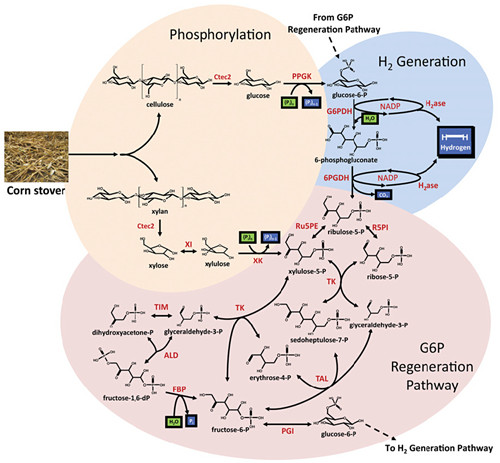Green Hydrogen Production from Biomass Catalyzed by Enzyme Cocktails
The hydrogen economy presents an energy future featuring high energy efficiency and nearly zero pollution. For example, Toyota and Hyundai start selling affordable hydrogen fuel cell vehicles this year. However, most hydrogen is produced from fossil fuels, such as natural gas and coal, resulting in net greenhouse gas emissions. In addition, current hydrogen production facilities equipped with high-temperature and high-pressure reactors require very high capital investment and large scale facilities. They cannot be scaled down to produce affordable hydrogen to local users, such as hydrogen fuel cell vehicles. Although a few solutions are proposed to produce carbon-neutral hydrogen in distributed facilities, few solutions are practical by considering product yield, separation cost, and reaction rates, involving production costs and capital investment. For example, water electrolysis is too costly because of high price tags of electricity (i.e., more than 5 cents/KWh); solar spitting powered by sunlight suffers from too slow reaction rate and low photo-to-chemical energy efficiency. Producing hydrogen from less expensive and evenly distributed biomass is an attractive alternative, but current methods have not produced sufficient yields and/or fast enough to date.
Prof. ZHANG Yiheng, who is affiliated with Tianjin Institute of Industrial Biotechnology, Chinese Academy of Sciences, and his co-workers in the USA, have now introduced an enzyme cocktail of more than 15 enzymes that can produce hydrogen from both glucose and xylose of corn stover, one of the most abundant agricultural residuals in the world.
Starting from corn stover, a commercial cellulase cocktail was used to hydrolyze biomass including cellulose and hemicellulose to glucose and xylose, respectively. They account for more than 95% biomass sugars. The team demonstrated to produce nearly 12 moles of hydrogen from one glucose and 10 moles of hydrogen from one xylose by using enzyme cocktails, three-times of the product yield of hydrogen-producing microorganisms.
The team of Chinese and American researchers has thus resorted to three tricks. First, they are using the enzyme cocktail instead of microorganisms, surpassing natural limit for microorganism. Second, they optimized the enzyme ratio by using mathematical modeling and validated predictions by using experimental data. They increased biohydrogen generation rates by 67 fold to 54 mmole of hydrogen per L per hour, which is comparable to those of high-speed biomethane generation. It means that the hydrogen production reaction rate is fast enough for industrial production, 15-times of the fastest photo biological hydrogen generation rate. Third, instead of complicated carbon flux regulation in microorganisms, the enzyme cocktail enabled to co-utilize both glucose and xylose at the same time.
This bioprocess mediated by in vitro artificial enzymatic pathway meets three biomanufacturing criteria (TRY): titer, rate and yield, at the same time. This bioprocess could become the best solution to produce affordable green hydrogen from renewable energy source. Local bioresource creates local green jobs and benefits local person. Furthermore, biomass could even serve as a high-density hydrogen storage carrier that could solve problems of hydrogen storage and distribution.
Gaseous hydrogen bubbles from the aqueous sugar solution at 50-60oC and 1 atm. This process has extra benefits such as, very low product separation costs, low capital investment, and high-purity hydrogen generation without CO. Different from ethanol fermentation, which requires high concentration sugar solutions, hydrogen can be produced and separated from low concentration sugar solutions easily, further decreasing its production cost.
Prof. ZHANG and his co-workers keep working on this project for more than eight years because they understand its importance for the hydrogen economy. They believe that the bioprocess will be scaled up within a short time because of its obvious benefits compared to current hydrogen production methods, for example, water electrolysis, and other developing technologies, such as solar water splitting. The remaining thing is integrative innovation by combining current enzyme production, enzyme engineering technologies and hydrogen’s end users for its scale-up.
The study entitled “High-yield hydrogen production from biomass by in vitro metabolic engineering: Mixed sugars coutilization and kinetic modelling” has been published in Proceedings of the National Academy of Sciences of the United States of America. A US patent was also issued (US 8,211,861).

Pathway depicting the enzymatic conversion of biomass to hydrogen and CO2.
(Image by Prof. ZHANG Yiheng‘s group)
